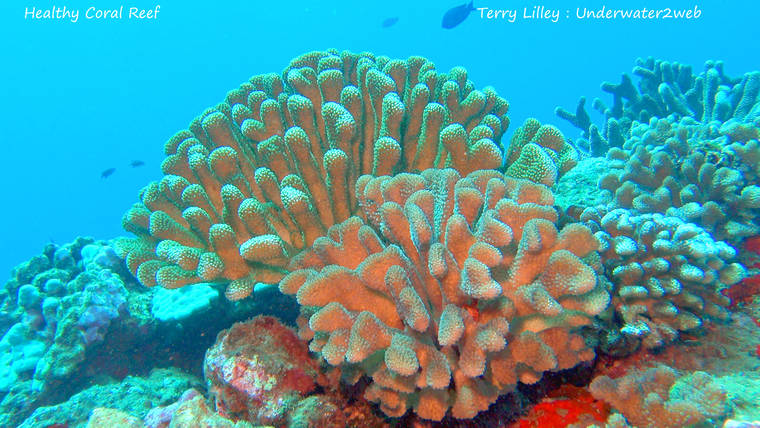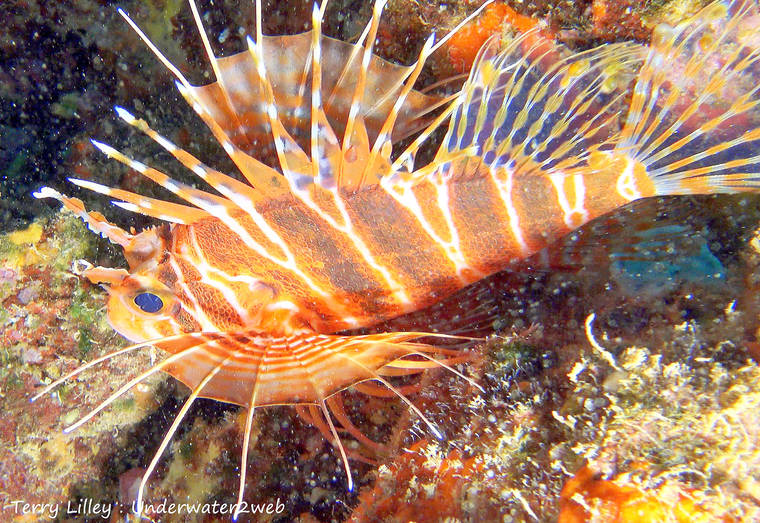A recent diving outing on the south side of Kauai found an array of colorful corals and fascinating fish.
Kauai’s Terry Lilley of underwater2web said in the dive just out of Port Allen he was stunned to see how good of shape the corals are. “Great coral cover and absolutely no bleaching or disease. The water was clear with no run off from rain.”
They dove from depths of 20 to 80 feet off a Garden Island Divers boat.
Parts of the reef were 70 to 80% covered in cauliflower and antler coral and there was a great deal of fish and many unusual invertebrates, Lilley said.
He is finishing up his new movie, “The Worlds Guide to Hawaiian Reef Creatures” and said he even shot video of some “super rare critters I needed for the production.”
Lilley said findings on his recent dive indicate that “it is obvious that warmer sea temperatures along are not causing bleaching events all on their own.”
He said the current water temperatures on the south side right are above 80 degrees and warmer than what he has felt before.
“At the same time some of our coral reefs in polluted areas of high sediment and chemical run off like Ahukini Landing are bleached and diseased,” he said. “It is good to dive the entire island within a 30-day period so we can compare reefs that are under the same weather and sea water temperature conditions.”
Experts monitoring the expected coral bleaching say it’s not as severe as was predicted by the National Oceanic and Atmospheric Administration in early September.
But it is widespread, in pockets, and monitoring the corals throughout this marine heat wave could help with future response to bleaching and coral research.
For the past two months, researchers conducted rapid assessments of coral health along coral reef tracts throughout the state.
They report cauliflower and rice corals were most impacted and that the ocean temperatures are already starting to cool off. However, as much as half of live coral bleached in the most heavily affected areas.
“Conditions for corals are now improving with sea surface temperatures beginning to drop,” said Gerry Davis with NOAA Marine Fisheries.
A recent collaboration between researchers at the University of Hawaii at Manoa School of Ocean and Earth Science and Technology, Hawaii Pacific University and the National Oceanic and Atmospheric Administration revealed for the first time growth rates of deep-sea coral communities and the pattern of colonization by various species.
The scientific team used the UH Manoa Hawaii Undersea Research Laboratory’s submersible and remotely-operated vehicles to examine coral communities on submarine lava flows of various ages on the leeward flank of the Island of Hawaii.
Utilizing the fact that the age of the lava flows — between 61 and 15,000 years — is the oldest possible age of the coral community growing there, they observed the deep-water coral community in Hawaii appears to undergo a pattern of ecological succession over time scales of centuries to millennia.
“This study was the first to estimate the rate of growth of a deep-sea corals on a community scale,” said Meagan Putts, lead author of the study and research associate at SOEST’s Joint Institute for Marine and Atmospheric Research. “This could help inform the management of the precious coral fishery in Hawaii.”
Putts said prior to beginning this work, it was unclear if a pattern of colonization existed for deep-sea coral communities and in what time frame colonization would occur.
“When put into context with what we do know about the life history of Hawaiian deep-water corals, the results of this work make sense,” she said.




Great news!!
Sorry… Iʻve seen plenty of bleaching exactly where lilley saw none. Hanapepe stream also dumps into this area… so much for runoff being the cause for bleaching per his other claims. Stick to the north shore
MAHALO TERRY LILLEY !! YOU ARE SO GENEROUS WITH YOUR FINDINGS AND TIME !
SOME PEOPLE MISS THE POINT…..LET’S BE CLEAR: IT IS MILITARY SONAR, RIMPAC GAMES, ON AND ON CAUSING HAWAII PRESCIOUS UNDERWATER BEAUTY TO MUCK MUCK.
WE ARE USED TO PEOPLE DISCOUNTING YOUR TRUTHS. CANNOT !!
Do you have recent pictures of the area you are talking about that we can access ? Any comparative pictures over the last year or two? How far offshore were you or was this a beach dive? Thank you.